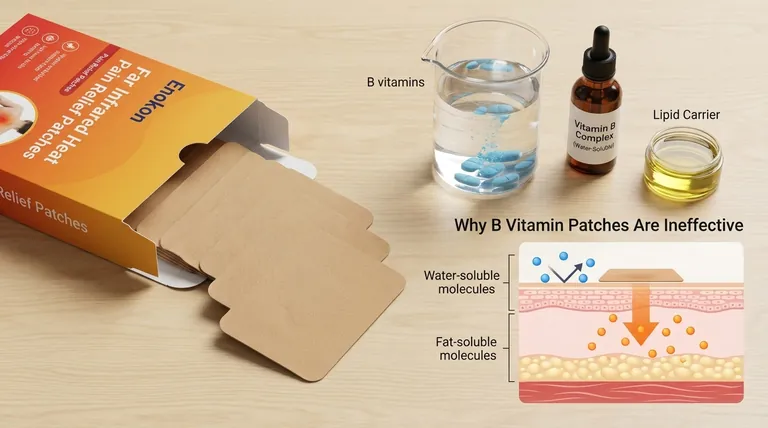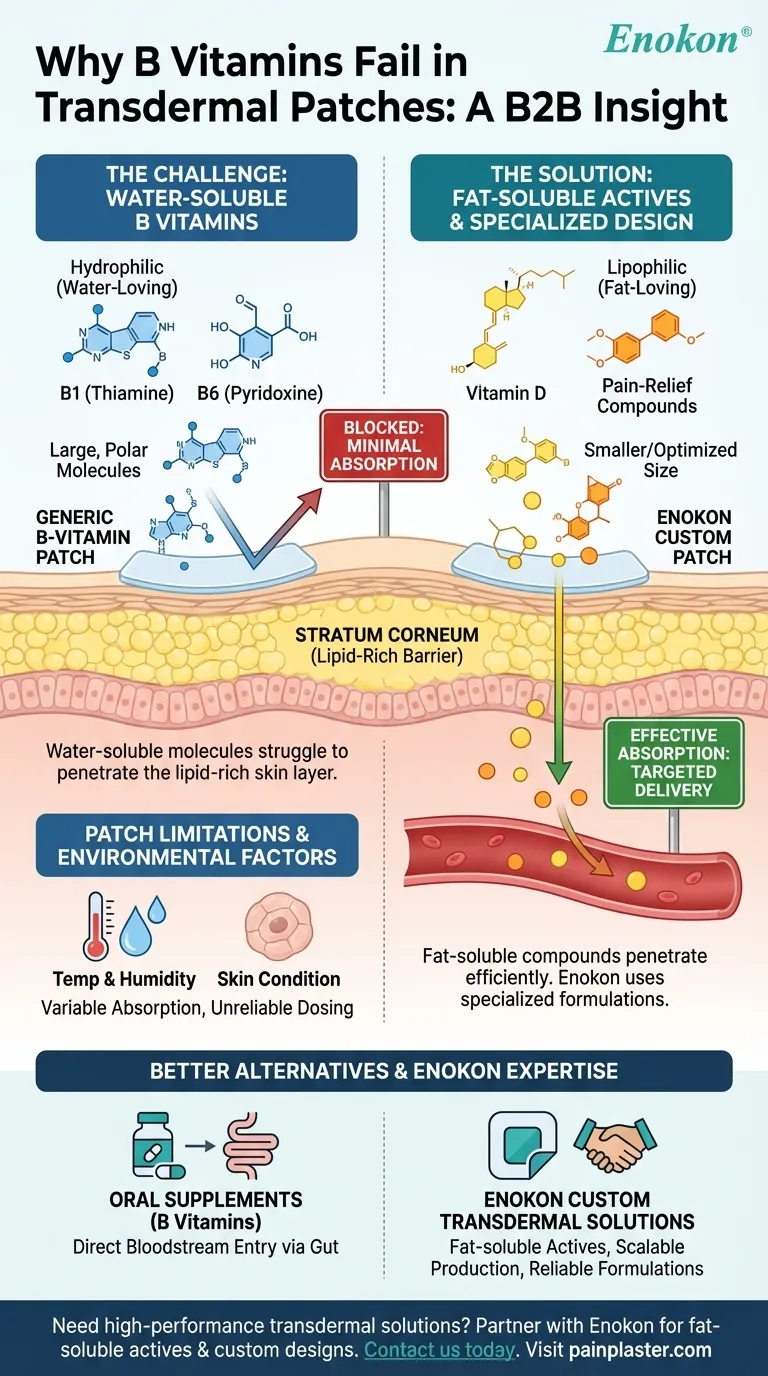B vitamins, particularly B1 and B6, are often touted for their benefits in managing period pain and PMS. However, their delivery via transdermal patches is largely ineffective due to their water-soluble nature, which contrasts with the fat-solubility required for skin absorption. Key factors like molecular size, polarity, and solubility further limit their transdermal efficacy. Patch design must account for these variables, but many existing patches fail to overcome these barriers, resulting in minimal or no absorption into the bloodstream. Understanding these limitations helps explain why alternative delivery methods, such as oral supplements, are more effective for B vitamins.

Key Points Explained:
-
Water-Solubility vs. Fat-Solubility
- B vitamins like B1 (thiamine) and B6 (pyridoxine) are water-soluble, meaning they dissolve in water rather than fats.
- Skin absorption requires fat-soluble compounds because the outermost layer of the skin (stratum corneum) is lipid-rich.
- This mismatch in solubility prevents B vitamins from penetrating the skin effectively when delivered via patches.
-
Molecular Size and Polarity
- Smaller molecules are absorbed more easily through the skin, but B vitamins are relatively large and polar.
- Lipophilic (fat-loving) compounds penetrate the skin more efficiently, whereas hydrophilic (water-loving) molecules like B vitamins struggle to cross the lipid barrier.
- Even if a patch claims to deliver B vitamins, their molecular properties hinder absorption.
-
Patch Design Limitations
- Effective transdermal patches must account for factors like solubility, molecular size, and skin condition.
- Many patches on the market contain ingredients that are neither fat-soluble nor small enough for meaningful absorption.
- Without specialized formulations (e.g., nanoencapsulation or chemical enhancers), B vitamins remain trapped in the patch or on the skin surface.
-
Environmental and Biological Factors
- Skin absorption is influenced by external conditions like temperature and humidity, as well as individual factors like age and skin health.
- Even under ideal conditions, water-soluble vitamins face significant barriers, making consistent dosing via patches unreliable.
-
Alternative Delivery Methods
- Oral supplements bypass the skin barrier entirely, allowing B vitamins to dissolve in the digestive tract and enter the bloodstream directly.
- For those seeking transdermal solutions, fat-soluble vitamins (e.g., D or E) or specially formulated compounds are more viable options.
Understanding these principles clarifies why B vitamins are better suited to oral rather than transdermal delivery, ensuring their therapeutic benefits are fully realized.
Summary Table:
| Key Limitation | Explanation |
|---|---|
| Water-Solubility | B vitamins dissolve in water, but skin absorbs fat-soluble compounds. |
| Molecular Size | Large, polar molecules struggle to penetrate the lipid-rich stratum corneum. |
| Patch Design Flaws | Most patches lack enhancers to overcome solubility/size barriers. |
| Environmental Factors | Absorption varies with skin health, temperature, and humidity. |
| Better Alternatives | Oral supplements or fat-soluble vitamins (D/E) are more effective. |
Need high-performance transdermal solutions? Enokon specializes in custom-designed patches for fat-soluble actives like vitamin D or pain-relief compounds. As a trusted bulk manufacturer for healthcare brands and distributors, we combine technical expertise with scalable production to deliver reliable, skin-compatible formulations. Contact us today to discuss your project!
Visual Guide

Related Products
- Far Infrared Heat Pain Relief Patches Transdermal Patches
- Heating Pain Relief Patches for Menstrual Cramps
- Capsaicin Chili Medicated Pain Relief Patches
- Medical Cooling Gel Patches for Fever Cooling Patches
- Far Infrared Deep Heat Relief Patches Medicated Pain Relief Patches
People Also Ask
- How quickly does the Deep Heat Pain Relief Back Patch activate and how long does it provide warmth? Get 16-Hour Relief
- Can heat patches be used for fresh injuries? Avoid This Common Mistake for Faster Recovery
- How do Deep Heat Pain Relief Patches provide pain relief? Discover the Drug-Free Mechanism
- What are the key features of the Deep Heat Pain Relief Back Patch? Get Up to 16 Hours of Drug-Free Relief
- How does the Deep Heat Back Patch work? A Drug-Free Solution for Targeted Pain Relief















